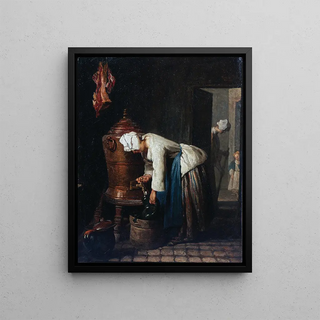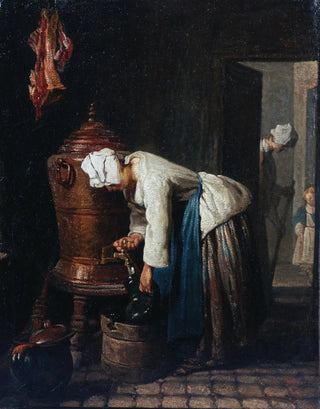Art print | Woman drawing water from the cistern - Jean Siméon Chardin


View from behind

Frame (optional)
In the vast panorama of art history, some artworks manage to capture the very essence of everyday life with such depth that they become timeless. "Femme puisant de l'eau à la citerne" by Jean Siméon Chardin is one of these creations. Painted in the 18th century, this piece does more than depict an ordinary scene; it evokes an atmosphere of serenity and contemplation, immersing the viewer in a moment of simple grace. The scene depicts a woman, with a delicate and focused silhouette, engaged in a daily task, but the way Chardin renders her alive transcends the banality of the subject. Every detail, every nuance of color, every lighting choice is designed to invite reflection on the beauty of the everyday.
Style and uniqueness of the work
Chardin's style is distinguished by its ability to blend realism and poetry. In "Femme puisant de l'eau à la citerne," the artist uses a palette of soft, natural colors, creating a visual harmony that soothes the mind. Light plays a crucial role, subtly illuminating the female figure while casting delicate shadows that add an almost tactile dimension to the canvas. The composition is carefully balanced, highlighting the woman at the center while integrating elements of her environment, such as the cistern and the surrounding landscape. This approach fosters an intimate connection with the subject, as if sharing a privileged moment of her life. Chardin manages to transform an ordinary action into a scene imbued with emotional depth, inviting the viewer to appreciate the hidden beauty in daily gestures.
The artist and his influence
Jean Siméon Chardin, an emblematic figure of the Rococo movement, knew how to leverage his era to redefine the genre of still life and genre scene. His training with the masters of the time and his penchant for meticulous observation of human nature nourished his work. Chardin does not merely reproduce reality; he interprets it with a unique sensitivity, placing the human at the heart of his artistic concerns. His influence extends to

Matte finish

View from behind

Frame (optional)
In the vast panorama of art history, some artworks manage to capture the very essence of everyday life with such depth that they become timeless. "Femme puisant de l'eau à la citerne" by Jean Siméon Chardin is one of these creations. Painted in the 18th century, this piece does more than depict an ordinary scene; it evokes an atmosphere of serenity and contemplation, immersing the viewer in a moment of simple grace. The scene depicts a woman, with a delicate and focused silhouette, engaged in a daily task, but the way Chardin renders her alive transcends the banality of the subject. Every detail, every nuance of color, every lighting choice is designed to invite reflection on the beauty of the everyday.
Style and uniqueness of the work
Chardin's style is distinguished by its ability to blend realism and poetry. In "Femme puisant de l'eau à la citerne," the artist uses a palette of soft, natural colors, creating a visual harmony that soothes the mind. Light plays a crucial role, subtly illuminating the female figure while casting delicate shadows that add an almost tactile dimension to the canvas. The composition is carefully balanced, highlighting the woman at the center while integrating elements of her environment, such as the cistern and the surrounding landscape. This approach fosters an intimate connection with the subject, as if sharing a privileged moment of her life. Chardin manages to transform an ordinary action into a scene imbued with emotional depth, inviting the viewer to appreciate the hidden beauty in daily gestures.
The artist and his influence
Jean Siméon Chardin, an emblematic figure of the Rococo movement, knew how to leverage his era to redefine the genre of still life and genre scene. His training with the masters of the time and his penchant for meticulous observation of human nature nourished his work. Chardin does not merely reproduce reality; he interprets it with a unique sensitivity, placing the human at the heart of his artistic concerns. His influence extends to






